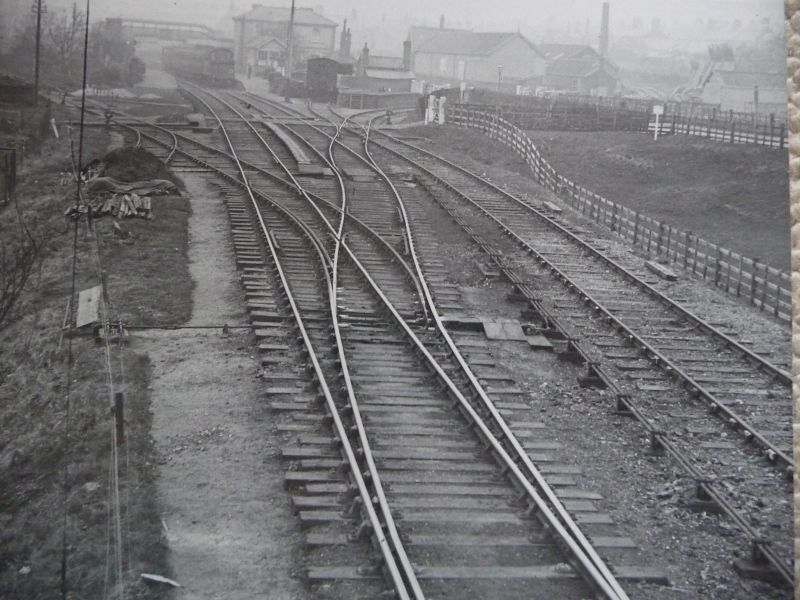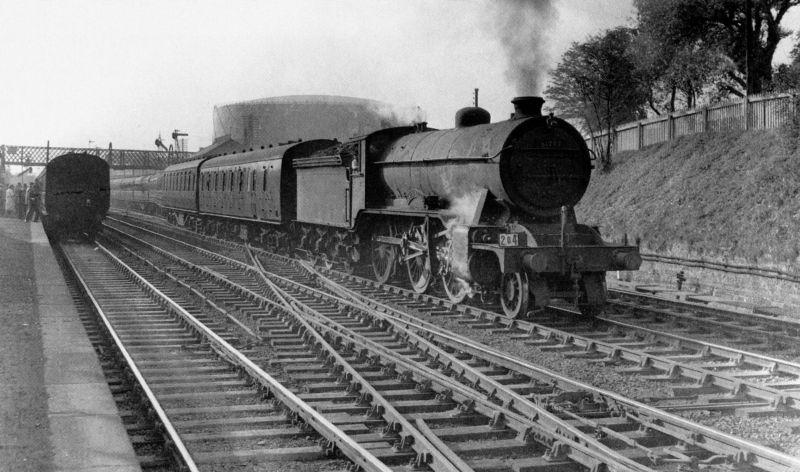Templot Club Archive 2007-2020
|
|||
| author | remove search highlighting | ||
|---|---|---|---|
|
posted: 13 Apr 2012 14:55 from: Howard
click the date to link to this post click member name to view archived images |
My club has a layout with double track main line and a bay platform (UK based, so left hand running). The bay is reached by a "single slip", but what exactly is a single slip? Suppose the 2 running roads are the Up & Down line, with the Down line furthest away from you. It seems to me there are 3 possibilities 1) Down to Down 2) Down to Bay 3) Bay to Up (via a point on the up line) Since (1) & (3) represent straight through routes, would these both be available at the same time - in other words are there only 2 possibilities? Or are there two different types of "single slips"? I've never used slips before, hence my question. |
||
|
posted: 13 Apr 2012 15:11 from: Les G click the date to link to this post click member name to view archived images |
Howard wrote: but what exactly is a single slip? Dear Howard, I "Ask"ed "single slip" and got this link Wikipedia link http://uk.ask.com/wiki/Railroad_switch which should give you a good bit of background explanation of turnouts and switches double and single. Then take look at Real Track in the companion. regards Les G |
||
|
posted: 13 Apr 2012 16:18 from: Martin Wynne
click the date to link to this post click member name to view archived images |
Howard wrote: but what exactly is a single slip?Hi Howard, Slip roads are added to a diamond-crossing to provide a connection between the two tracks. slip_road.png There are 3 possible routes through a single-slip, and 4 possible routes through a double-slip. But only one route can be used at any given time. If the side roads are completely outside the diamond-crossing, so that both side roads can be used at the same time, it is not called a slip. That arrangement is called a half-scissors for one side road, and a full-scissors or scissors crossover for two side roads. regards, Martin. |
||
|
posted: 13 Apr 2012 16:19 from: Nigel Brown click the date to link to this post click member name to view archived images |
Hi Howard 2) and 3) wouldn't be available at the same time. The slip has two pairs of switches, one on the down line, and one on the bay line. The bay line switches can either be aligned to connect to the down line (case 2)or be aligned to cross the down line to connect with the up line (case 3). If you want (2) then you must also have the down line switches aligned to connect with the bay platform. In (1) the setting of the bay line switches doesn't matter. In (3) the setting of the down line switches doesn't matter. Hope that helps Nigel |
||
|
posted: 13 Apr 2012 16:28 from: Howard
click the date to link to this post click member name to view archived images |
Thanks Martin for a very clear explanation, So we have a single slip, and not a half scissors. Howard. |
||
|
posted: 16 Apr 2012 16:53 from: Godwinpa
click the date to link to this post click member name to view archived images |
Howard, Now you know what a single slip is, I would add that single slips in UK main lines are traditionally only used in the trailing direction. That is that no approaching train on the mainline could suffer a change of direction as a result of the slip switch being set incorrectly. So on Martins diagram, mainline trains would be permissible running on the horizontal track from the right to the left, but not left to right. Even facing points were avoided if at all possible and if they were needed, such as at a junction, they would have a point lock that could only be activated if the switch is confirmed to be positively set in the right direction. Modellers commonly forget this in an effort to save space on layouts and this results in unrealistic track formations. This rule applies in the UK even for slow speed areas except, perhaps at terminii. In Victorian times the vigorous application of this rule resulted in some bizarre track formations that must be a whizz to model! In mainland Europe slips were (are?) quite common on track layouts in places you'd never find them in the UK. Regards, Paul Godwin |
||
|
posted: 16 Apr 2012 18:06 from: John Lewis
click the date to link to this post click member name to view archived images |
Paul, As always there are exceptions to the "rule". At Sittingbourne there is/was a facing slip in the down main so that down trains from Sheerness could access the down loop platform and return via the up line. The speed limit on the main line at Sittingbourne was 90mph. As for bizarre track formations the GWR were known to have a passing loop at stations on a single line where the goods yard was on the (say) up side of the line, the point leading to it was off the down line and the yard access then crossed the up line with a plain diamond, thus avoiding a facing point. |
||
|
posted: 16 Apr 2012 19:57 from: Martin Wynne
click the date to link to this post click member name to view archived images |
John Lewis wrote:As for bizarre track formations the GWR were known to have a passing loop at stations on a single line where the goods yard was on the (say) up side of the line, the point leading to it was off the down line and the yard access then crossed the up line with a plain diamond, thus avoiding a facing point.Hi John, A common arrangement. Here's Rubery on the Halesowen branch: http://www.photobydjnorton.com/RailwayPictures/RuberyStnfromDownHome.jpg From this excellent site: http://www.photobydjnorton.com Often the diamond-crossing had a slip road added to make a trailing crossover, as here at Three Cocks Junction: trailing_slip.jpg  © unknown regards, Martin. |
||
|
posted: 16 Apr 2012 21:10 from: TimRKirby
click the date to link to this post click member name to view archived images |
Martin Wynne wrote: Often the diamond-crossing had a slip road added to make a trailing crossover, as here at Three Cocks Junction: trailing_slip.jpg  © unknown That link appears to be somewhat broken, Martin (p.s. the 404 generated an error too - Additionally, a 404 Not Found error was encountered while trying to use an ErrorDocument to handle the request ) |
||
|
posted: 16 Apr 2012 21:15 from: Martin Wynne
click the date to link to this post click member name to view archived images |
Hi Tim, I've made a few changes to the web site. If you are not seeing the picture it is because your DNS has not yet updated. Please try again later. Or try this instead: trailing_slip.jpg regards, Martin. |
||
|
posted: 16 Apr 2012 21:27 from: TimRKirby
click the date to link to this post click member name to view archived images |
That link worked just fine, thanks... | ||
|
posted: 16 Apr 2012 23:08 from: Nigel Brown click the date to link to this post click member name to view archived images |
Fascinating bit of track there at Three Cocks junction, Martin. Just cries out to be built! Cheers nigel |
||
|
posted: 17 Apr 2012 10:56 from: Godwinpa
click the date to link to this post click member name to view archived images |
John has identified the inevitable exception to thr ule. The late Cyril Freezer would have put this into his "prototype for everything department". The Victorians went to great lengths to avoid facing points. See this example from Braintree (Essesx) from 1910: 2399_170555_330000000.jpg  Regards, Paul Godwin |
||
|
posted: 17 Apr 2012 13:08 from: allanferguson
click the date to link to this post click member name to view archived images |
Godwinpa wrote: Howard, I used to travel over this at about 60mph. I didn't know about such things then! It's in the fast road of the Glasgow and Paisley Joint, at Ibrox Junction.176_170807_000000000.jpg  Allan F |
||
| Attachment: attach_1427_1923_Ibrox_slip720.jpg 595 | |||
|
posted: 4 Jun 2012 12:12 from: sm
click the date to link to this post click member name to view archived images |
That's a great photo, thanks for sharing, That track formation is crying out to be modelled. Forgive me for asking and perhaps I'm showing my ignorance but surely the first set of switch blades is facing and the odd trackwork is to gain the correct angle for entry to the siding? Godwinpa wrote: John has identified the inevitable exception to thr ule. The late Cyril Freezer would have put this into his "prototype for everything department". |
||
|
posted: 4 Jun 2012 14:19 from: allanferguson
click the date to link to this post click member name to view archived images |
Doing it this way there's only one facing point, with it's associated (and expensive) facing point lock. On single line railways with passing loops, any connections were almost always arranged to be trailing, even if that involved odd configurations, as here. But there were always exceptions -- see Ibrox above! Allan F |
||
| Please read this important note about copyright: Unless stated otherwise, all the files submitted to this web site are copyright and the property of the respective contributor. You are welcome to use them for your own personal non-commercial purposes, and in your messages on this web site. If you want to publish any of this material elsewhere or use it commercially, you must first obtain the owner's permission to do so. |
